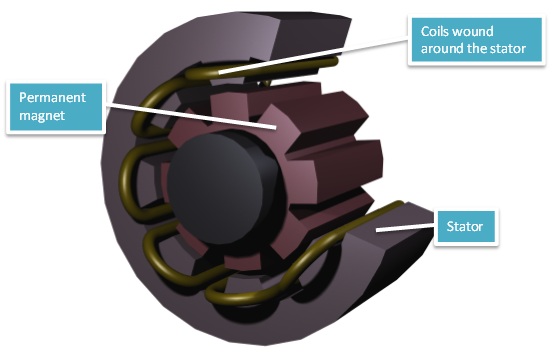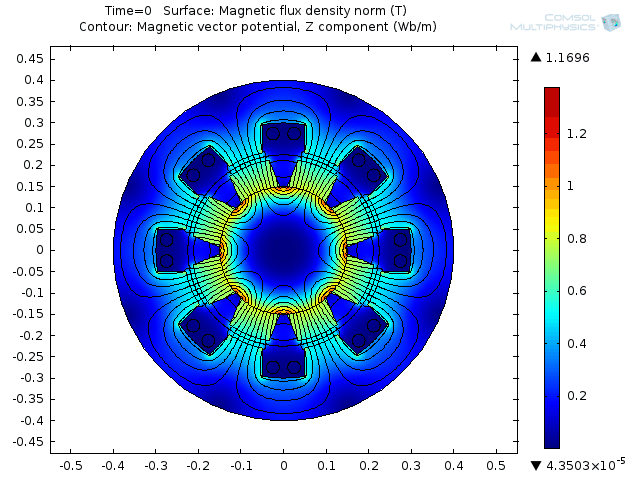
Permanent magnet generators, or PM generators as they are also called, generate power without batteries. PM generators consist of a magnetic stator coiled with wire and a wheel with permanent magnets rotating inside the stator. From motorcycles to wind farms, PM generators can be used in many electrical machinery applications. Let’s take a look at how these types of generators work and how they can be simulated.
How Permanent Magnet Generators Work
Essentially, a wire is wound around a stator made of material with high relative permeability. Inside the stator you have a wheel, or rotor, which consists of a center (made up of the same material as the stator) and permanent magnets that create a strong magnetic field. These permanent magnets are typically rare-earth elements, such as samarium for example.
When the rotor is set in motion a current is induced. That is because the electromagnetic fields (EMF) of the permanent magnets on the rotor move past the coiled stator. As the magnets are spaced out like teeth on the rotor, the strength of the EMF fluctuates up and down as the rotor spins. It is this continuous flux that induces the current into the stator wire. Naturally, the faster the rotor spins, the higher the voltage output.

2D Simulation of a PM Generator in COMSOL Multiphysics
I came across a great example of a PM generator when browsing our online Application Gallery. The model shows how the rotation of the rotor with permanent magnets generates an induced EMF in the winding. The voltage is calculated as a function of time during the rotation. Also depicted in the model is the influence on the voltage from material parameters, rotation velocity, and number of turns in the wire winding.
The simulation below was produced by my colleague Valerio so that you can see the model in action:

A brighter color can be observed where the permanent magnets are positioned on the rotor.
As usual, if you have a COMSOL Access account you can download the model documentation of the generator model to read more about it. If you also have COMSOL Multiphysics and the AC/DC Module you may download the model files and explore this multiphysics problem further.
Applications of PM Generators
According to an article published on windpowerengineering.com (Generators 101) permanent magnet generators are used in the wind industry mainly because they do not require a battery to run. The wind is used to set the rotating wheel in motion, and off it goes generating a current. The zero-battery aspect is so important because wind farms tend to be located in remote areas. Harnessing wind power via PM generators requires less maintenance than generators that contain a battery that needs to be replaced every so often.
If you’re interested in motorcycles, you might know that PM generators can also be used to power your bike. I came across an interesting article on how to assemble a permanent magnet alternator for your motorcycle. Thought I’d share it with those of you who are handy in the shop.




Comments (12)
Aruna Shah
February 8, 2013Hi,
I have some confusion about this model .One thing that confused me is the coil in this model. In the model there is nothing that mention about the coil and there is no boundary condition for the coil too.
Please let know how coil domain is used in this model.
thank you
Fanny Griesmer
February 8, 2013 COMSOL EmployeeHi Aruna,
Please check out the model in our Model Gallery: https://www.comsol.com/model/generator-in-2d-2122
If you log into your COMSOL Access account you can get the documentation for this model, which explains how to simulate it in COMSOL. (If you don’t have an Access account, you can create one for free following the on-screen instructions).
Hung Vu
September 21, 2013Hi, some softwares can simulate 3D transient simulation including rotor motion of electric machines for calculating eddy current distribution in the rotor. Is Comsol 4.3b able to do that? I have no evidence to say yes.
Fanny Griesmer
September 24, 2013 COMSOL EmployeeYes, if you use COMSOL Multiphysics together with the AC/DC Module you can model the induced eddy currents in the rotor in any type of rotating machinery. The induced eddy currents in the rotor is simulated in the “rotating_machinery_3d_tutorial.mph” example from the Model Library.
B santosh sarma
December 20, 2013hi,i am doing m tech and i am doing project on renewable energy source in which i am using Bicycle Dynamo(bottle type) so the thing is that can i simulate the characteristics of bicycle dynamo in COMSOL as the output of the dynamo is ac
if so which part of COMSOL i have to download and one more thing i have to get the transfer function of the dynamos can it possible to get through this software
Mu
October 28, 2014Hi ;
I was reading the model documentation pdf , and took a quick look at the model .mph file . I would say it was really interesting, However I am confused of not adding the Moving Mesh (ALE) physics ! does that effect the results ? since the mesh does not moving ! only the spatial coordinates moves !
I tried to add the moving mesh by my self , but i got stuck with x,y,z and X,Y,Z variables which seems there is a variable looping which COMSOL cant take it ! and when using the Material coordinates X,Y,Z , the mesh also doesn’t move !!
any explanation ! ?
Best Regards ;
priya jaspal
October 20, 2015Hi,
I am new to comsol. I was wondering if this model includes the stator winding also as in the materials list I only see air and soft iron. I do not see copper anywhere which is commonly used as winding material.
please let me know how this is included.
Fanny Griesmer
October 21, 2015 COMSOL EmployeeHello Priya,
In this particular example, we are demonstrating how to compute the induced voltage in domains using the line integral of the electric field.
Alternatively, you could apply a Multi-Turn Coil feature to these domains and automatically compute the induced voltage in the windings. If you apply the Multi-Turn Coil feature, the conductivity value will be specified in the settings window of the Multi-Turn Coil feature.
Here is another tutorial model, which uses the Multi-Turn Coil feature: http://www.comsol.com/model/mutual-inductance-and-induced-currents-in-a-multi-turn-coil-12687
priya jaspal
October 30, 2015Fanny,Thanks for reply
I want to see the effect of different winding materials on generator’s performance.
How many multi turn coils would be required? What changes i would need to make to calculate efficiency of generator ?
Fanny Griesmer
October 30, 2015 COMSOL EmployeeHi Priya,
I would suggest that you contact your COMSOL support team with your questions so they can help you.
Online support center: https://www.comsol.com/support
Email: support@comsol.com
busayapol paophan
April 9, 2018Hi Fanny Littmarck
I have tried it but i cannot plot 1D. The program told me, Unknown function or operator.
– Name: comp1.intop1
– Plot: glob1 (Global)
I dont know how to solve this problem.
Pls let me know what i wrong to do it.
I used comsol version 5.2
thank you
bhargav saini
July 1, 2022if you want to purchase a permanent magnet alternator which is manufactured by J.D. Engineering Works. They offer the most excellent Synchronous Permanent Magnet Alternator in any voltage AC and DC. They are using top quality copper and are eco friendly. Provide higher efficiency without any maintenance.
More info:- https://www.pmsgen.in/permanent-magnet-alternator.html